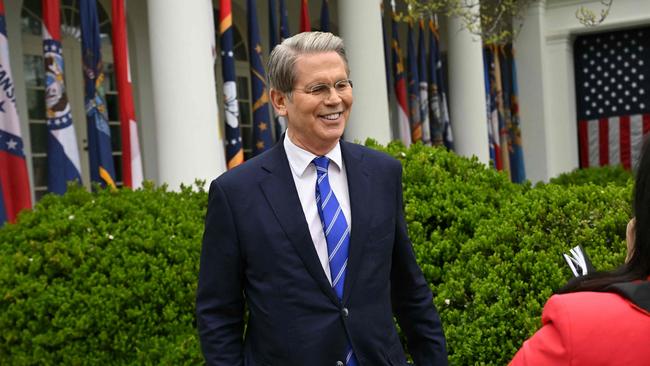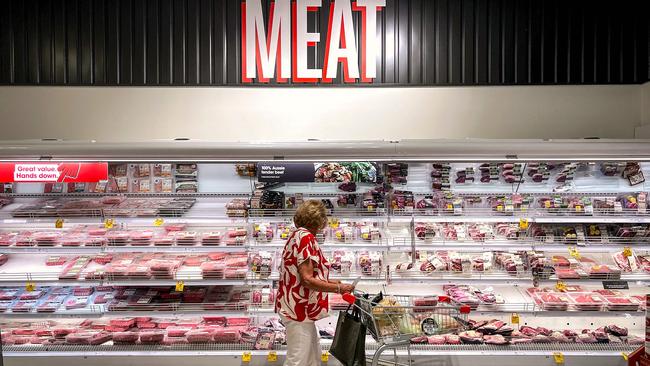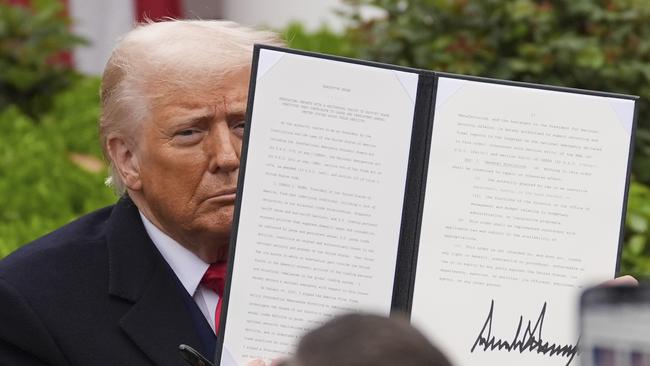Deep correction in stocks feared as tariffs shock markets and Aussie dollar falls
On a day in which $58bn was initially wiped from the value of Australian stocks, the ASX limped home from tariff shock in a less perilous state but experts say a big correction is on the way.

Business
Don't miss out on the headlines from Business. Followed categories will be added to My News.
Volatility on global markets will continue after US President Donald Trump announced bigger-than-expected tariff increases, sparking sharp falls in risk assets and gains in safe havens on Thursday.
Although investors initially wiped more than $58bn wiped off the value of Australian stocks, the ASX 200 subsequently halved its intraday fall and closed down just 0.9 per cent at 7859.7 points.
Australian companies facing US tariff increases included Ansell and Cettire, shares of which both fell 14 per cent on Thursday. However, gold miners soared and James Hardie rose 2.8 per cent.
Volatility in Australian stocks and regional markets came as S&P 500 futures in the US fell as much as 4.1 per cent before a modest rebound left them down 3 per cent heading into European trading.
Euro Stoxx 50 futures fell 1.9 per cent. Japanese stocks fared worse, with the Nikkei 225 down 3 per cent as the Japanese yen soared 1.6 per cent to a three-week high of 146.93 per US dollar.
If the sell-off in US stocks is sustained in regular trading, the US benchmark will cross the threshold of a 10 per cent “correction” from a record high of 5144.15 points six weeks ago.

In commodity markets, safe-haven gold rose as much as 1.1 per cent to a record high of $US3,167.84 per ounce before giving up its rise. US copper fell as much as 4.2 per cent and West Texas crude oil futures fell 3.4 cent to $US69.27 a barrel. The US 10-year bond yield dived 18 basis points to a six-month low of 4.045 per cent, sparking a similar flight to Australian government bonds.
The Australian dollar fell 1.2 per cent to a three-day low of US62.26c before recovering.
The intraday rebound in stocks and the Australian dollar came as US Treasury Secretary Scott Bessent signalled that the figures unveiled on Wednesday represented the “high end” of the duties, provided countries don’t react with their own measures.
“I wouldn’t try to retaliate,” Bessent said on Bloomberg TV.
“As long as you don’t retaliate this is the high end of the number.”
However, markets are bracing for economic fallout after President Donald Trump said a minimum 10 per cent US “reciprocal tariff” on all countries except Mexico and Canada would take effect on April 5 and higher tariffs would apply to many countries from April 9.

Australia wasn’t spared from the 10 per cent reciprocal tariff, with Mr Trump highlighting a lack of US beef exports to Australia versus what it exports to the US.
China faces a 34 per cent tariff increase that will take the average level of tariffs on its US exports to 54 per cent. Tariffs above the 10 per cent baseline increase will account for VAT tax rates and other non-tariff barriers, and be levied at half the total that each country is “charging” the US, Mr Trump said.
However, in a statement published Wednesday night to explain its methodology for tariffs that rocked the globe, the US Trade Representative detailed a formula that divides a country’s trade surplus with the US by its total exports, based on data from the US Census Bureau for 2024.
That number was divided by two, producing the “discounted” rate.
The USTR said that while it was technically possible to calculate rates for actual barriers, this methodology would achieve Mr Trump’s goal of driving down trade deficits.

The President invited negotiations with trading partners, although he specified that this would require lower tariffs or non-tariff barriers or additional inward investment into the US.
Exemptions were made on copper, pharmaceuticals, semiconductors, bullion, lumber articles, and energy, plus certain minerals not available in the United States.
Analysts said the imposition of tariffs was far from over and retaliation by other countries was on the cards.
However, the White House’s executive authority is likely to be challenged in the courts.
Mr Trump announced the tariffs using the International Emergency Economic Powers Act, which hasn’t been used to announce such sweeping changes to economic policy. Businesses are set to intensify their lobbying and political pressure to ease tariffs could mount as economic costs rise.
But market uncertainty is likely to remain elevated in the weeks ahead as investors consider likely downgrades to consensus US economic and earnings growth forecasts, the risk of a tit-for-tat escalation in tariffs, and the potential scope for tariffs announced to be negotiated down.

“All of this is likely to mean an extended period of volatility for US equities,” UBS Global Wealth Management chief investment officer Mark Haefele said.
“Nonetheless, we do believe the market will end the year higher and continue to see strong long-term potential in our artificial intelligence, longevity, and power and resources, transformational innovation opportunities, which could get caught up in near-term de-risking.”
He expected this to cause a tariff-related slowdown in growth in the second and third quarters of 2025.
The Trump administration’s actions had already increased the US effective tariff rate from 2.5 per cent to approximately 9.0 per cent – the highest since World War II.
Economists said Wednesday’s announcements would lift the average effective US tariff rate by about 15 percentage points, to around 25 per cent.
“Even if tariffs are ultimately reduced by year end, the near-term shock and associated uncertainty is likely to drive a near-term slowdown in the US economy and reduce full-year 2025 growth to closer to or below 1 per cent,” Mr Haefele said.
But in his view policy news from the US administration was likely to become incrementally “more supportive” as we approach the second half of the year.
“Now that the tariffs have been announced, negotiations to soften them can begin,” he said.
“Tariff revenue could be used to offset the cost of extending tax cuts, and we would expect the Fed to respond to weakening growth with interest rate cuts.
“The announced tariffs will have a negative impact on Europe and China, and after year-to-date rallies in markets, a period of near-term de-risking is possible – particularly if retaliatory measures are announced.
“For now, we recommend selectivity favouring beneficiaries of increased fiscal spending and small to mid-cap stocks in Europe, while in Asia we are drawn to Taiwan’s structural growth market and defensive strategies centred on mainland China’s state-owned enterprises.”
Pullbacks in both markets could give opportunities for underallocated investors to build up their exposure to underlying positive long-term drivers in both regions; Europe was likely to benefit from higher fiscal spending and China from its recent more pro-business tilt.
More Coverage
Originally published as Deep correction in stocks feared as tariffs shock markets and Aussie dollar falls
Read related topics:Donald Trump





